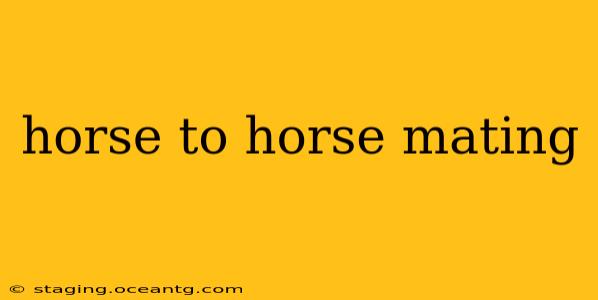Horse breeding, or equine mating, is a fascinating and intricate process. Understanding the nuances of how horses mate is crucial for both hobbyist breeders and professional stud farms. This guide delves into the complexities of horse-to-horse mating, covering everything from the natural process to assisted reproductive technologies.
What is the natural mating process for horses?
Natural mating, also known as pasture breeding, involves the stallion and mare freely interacting in a controlled environment. The stallion will display courtship behaviors, such as sniffing the mare's urine and genitalia, before attempting to mount and copulate. Successful mating requires the mare to be in estrus (heat), a period of sexual receptivity. This process is governed by complex hormonal cycles, and careful observation of the mare's behavior is crucial to determine optimal timing.
How do I know if my mare is in heat?
Determining if your mare is in heat is crucial for successful natural mating. Key indicators include:
- Winking: The vulva will visibly swell and may even slightly open and close, a behavior known as "winking."
- Urination: The mare will urinate frequently, often lifting her tail slightly.
- Tail Swishing: The mare will frequently swish her tail.
- Standing to be Mounted: The most definitive sign is her willingness to stand still when approached by a stallion, exhibiting a posture receptive to mating.
- Increased vocalizations: Some mares will become more vocal during estrus.
It's important to note that these behaviors can vary between individual mares. Consulting an equine veterinarian or experienced breeder is recommended for accurate assessment.
What are the different methods of artificial insemination (AI) for horses?
Artificial insemination (AI) offers a controlled alternative to natural mating, providing benefits such as increased safety for both the stallion and mare, greater access to superior genetics, and the ability to breed mares at optimal times, even if a stallion is geographically distant. There are several methods of AI, including:
- Fresh semen AI: This method utilizes semen collected immediately before insemination.
- Cooled semen AI: Semen is cooled and transported, extending its shelf life for several days.
- Frozen semen AI: This allows for the long-term storage and transportation of semen, enabling access to stallions long after they've passed away.
What are the risks and complications associated with horse mating?
While generally a natural process, both natural mating and AI carry potential risks:
- Injury: Natural mating can lead to injuries to both the stallion and mare, particularly if the stallion is aggressive or the mare is unreceptive.
- Disease transmission: Both natural mating and AI can transmit infectious diseases. Strict hygiene and veterinary oversight are essential to minimize this risk.
- Pregnancy complications: Pregnancy in mares can encounter complications such as abortions or dystocia (difficult birth).
- Infertility: Both stallions and mares can experience infertility issues.
What is the gestation period for a horse?
The gestation period for horses is approximately 11 months, or 335-345 days. Careful monitoring of the mare throughout her pregnancy is essential to ensure a healthy outcome.
How can I prepare for the birth of a foal?
Preparing for the birth of a foal requires planning and anticipation. This includes:
- Finding a veterinarian: Ensuring access to experienced equine veterinary care is crucial.
- Preparing a foaling stall: A clean, spacious, well-bedded stall is vital for a safe and comfortable foaling.
- Monitoring the mare: Close observation of the mare in the final stages of pregnancy is essential to identify signs of impending labor.
Horse-to-horse mating is a complex process that involves careful planning, observation, and expertise. This detailed guide provides a comprehensive overview, but consulting with equine professionals for specific guidance based on individual circumstances is always recommended. Remember, responsible breeding practices prioritize the health and well-being of both the stallion and the mare.
